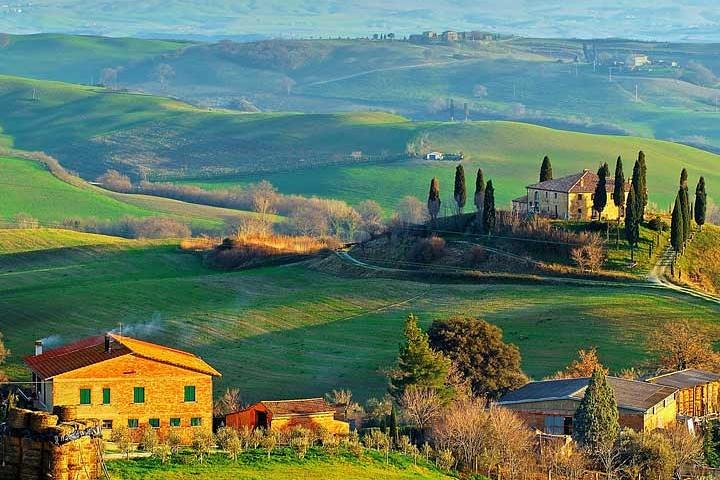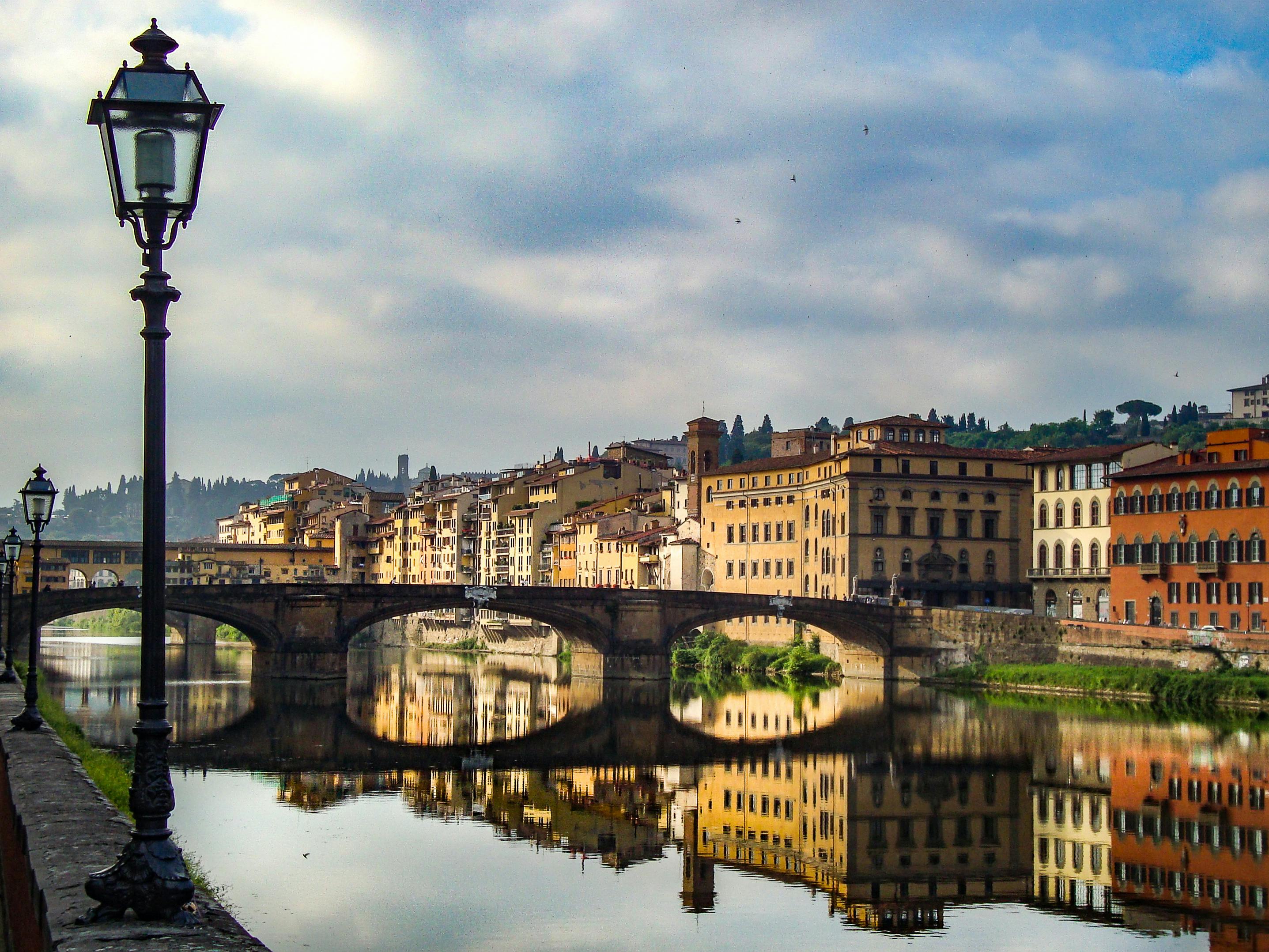2 Perfect Days in Florence: Renaissance Art, Tuscan Food, and Hidden Oltrarno
Florence is the Renaissance city where banking princes and master painters remade Europe. The Medici family financed genius; Brunelleschi lifted a dome the world thought impossible; Michelangelo gave marble a heartbeat. Today, the city center is a living museum—compact, walkable, and brimming with art that still startles.
Beyond the galleries, Florence rewards curiosity: goldsmiths glint on the Ponte Vecchio, artisans hammer leather and carve wood in the Oltrarno, and “wine windows” (buchette del vino) hide in palace walls. Coffee bars hum by morning; trattorie fill with bistecca alla fiorentina, ribollita, and pappardelle al cinghiale by night.
Practical notes: reserve top sights in advance (Uffizi, Accademia, Duomo dome). The historic center is a ZTL (limited-traffic zone)—avoid driving. Dress respectfully for churches, watch for pickpockets in crowds, and bring a refillable bottle; fountains provide great water. This 2-day itinerary prioritizes proximity and flow so you see more, wander better, and eat exceptionally well.
Florence
Florence (Firenze) is compact and best explored on foot. Santa Maria Novella station anchors the west, the Duomo towers over the center, and the Arno River flows beneath graceful bridges toward the artisan quarter of the Oltrarno. Distances are short, but the layers of history are deep.
Highlights blend showstopping art with daily rituals: a stand-up espresso, a market lunch shoulder-to-shoulder with locals, a late golden hour above tiled rooftops. Expect world-class museums, tiny workshops, and some of Italy’s most memorable meals.
- Top sights: Uffizi Gallery, Accademia (Michelangelo’s David), Duomo and Baptistery, Ponte Vecchio, Piazza della Signoria, Boboli Gardens.
- Experiences: artisan studios in the Oltrarno, a guided food walk, gelato tastings, and a Chianti countryside wine outing.
- Flavors to try: lampredotto (Florentine street-food), bistecca alla fiorentina, ribollita, cantucci with Vin Santo, and small-batch gelato.
Where to stay
- Browse apartments and homes on VRBO Florence or hotels via Hotels.com Florence.
- Four Seasons Hotel Firenze – A landmark urban resort with a private park; serene base near Santa Croce.
- The St. Regis Florence – Riverside grandeur and refined service steps from the Arno.
- Hotel Brunelleschi – Boutique elegance inside a medieval tower moments from the Duomo.
- Grand Hotel Minerva – Stylish rooms and a rooftop pool overlooking Piazza Santa Maria Novella.
- Hotel Davanzati – Friendly, central, great value between the Duomo and the river.
- Hotel Dali or Hotel Santa Croce – Budget-friendly, walkable to major sights.
- Hotel Della Signoria – Quiet comfort just off Piazza della Signoria.
Getting there and around
- Flights: Compare to Florence (FLR) or Pisa (PSA) with Omio flights (Europe). From PSA, trains to Firenze S.M.N. take ~1–1.5 hours.
- Trains: High-speed routes on Omio trains: Rome→Florence ~1h30–1h40 (€25–60), Milan→Florence ~1h55–2h10 (€29–70), Bologna→Florence ~35–45 min (€15–35).
- Buses: Budget coaches on Omio buses link Tuscan towns and nearby regions.
- Airport transfer: From FLR, the T2 tram to Unità/Alamanni (near S.M.N.) takes ~20 min and costs ~€1.70–2.00.
- On foot: Most sights lie within a 15–20 minute walk; taxis are plentiful; no need for a car in the ZTL core.
Day 1 — Renaissance Icons and a Riverfront Sunset
Morning: Travel into Florence and drop bags at your hotel. If you arrive early by train, pause for a classic stand-up espresso and a crema-rich cappuccino at historic bars like Caffè Gilli or Scudieri by the Duomo; pair with a sfoglia (flaky pastry) or a rice pudding tart slice.
Afternoon: Meet a guide at the Accademia to see Michelangelo’s David without the long lines. You’ll learn how the 17-foot marble once stood outdoors in Piazza della Signoria before becoming the city’s emblem. After, stroll via San Lorenzo toward the Duomo to admire the polychrome facade and Giotto’s bell tower; consider stepping into the Baptistery to see the ceiling mosaics.
Florence Accademia Gallery Tour with Entrance Ticket Included (skip-the-line)

Lunch ideas nearby: join locals at Trattoria Mario (no-frills, legendary bistecca and handmade pasta; arrive early or be ready to share a table), or head to Mercato Centrale upstairs for a quick bowl of fresh pici cacio e pepe, a porchetta panino, or a plate of Tuscan salumi with pecorino. For a fast bite, All’Antico Vinaio’s schiacciata sandwiches (try “La Favolosa”) are famous for a reason.
Evening: Cross the Arno to the Oltrarno and climb to Piazzale Michelangelo for golden-hour city views; the copy of David up top nods to what you saw earlier. Dine in this neighborhood: Trattoria La Casalinga (home-style classics), Osteria Santo Spirito (creamy truffle gnocchi), or Il Santo Bevitore (contemporary Tuscan with a deep wine list). Nightcap suggestions: Manifattura (all-Italian spirits, elegant), Rasputin (speakeasy, reservations recommended), or a riverside amaro as you stroll back over the Ponte Vecchio. Finish with gelato at La Carraia (pistachio and ricotta-pear are standouts).
Day 2 — Masterpieces, Artisan Lanes, and Tuscan Flavors
Morning: Start with specialty coffee at Ditta Artigianale (order a flat white or a single-origin espresso flight) and a still-warm cornetto. Then dive into Botticelli, Leonardo, and Caravaggio on a guided Uffizi visit—priority entry saves precious time, and a great guide connects the artists to the Medici story. Afterward, amble to Piazza della Signoria (public “open-air museum”) and across the Ponte Vecchio to peek at jewelers’ windows.
Uffizi Gallery Small Group Tour with Guide (skip-the-line)

Lunch: Try Da Nerbone inside Mercato Centrale (iconic bollito or lampredotto panino with green salsa), or grab a stool at Procacci for tiny truffle sandwiches and a glass of Franciacorta. If you prefer a sit-down meal, Osteria dell’Enoteca does a terrific tagliata with Brunello by the glass.
Afternoon (Option A — In the city): Wander the Oltrarno’s artisan grid: Via Maggio’s antiques, leather ateliers, printmakers, wood inlay. Then head into the Boboli Gardens behind Palazzo Pitti for grand Renaissance landscaping, grottoes, and skyline views. Coffee break at S. Forno (country bread bakery) or gelato at Gelateria dei Neri (try salted caramel or pistachio).
Afternoon (Option B — Countryside): If you’d rather taste Tuscany among vineyards, join a small-group Chianti outing that visits two wineries for cellar tours and guided tastings—olive oil and cypress-lined roads included. It’s a half-day with easy pickup near the center.
Small-Group Wine Tasting Experience in the Tuscan Countryside

Evening: Cap your trip with a guided food stroll through Florence’s historic center and Oltrarno. You’ll sample DOCG wines, discover a “wine window,” try crostini neri, a zero-waste soup like ribollita, and end with artisan gelato—plus the stories behind each bite. It doubles as dinner and local orientation.
Winner 2025 Florence Sunset Food & Wine Tour by Eating Europe

Prefer a hands-on finale instead? Consider a pasta-and-tiramisu class with dinner and local wine, then toast the Arno from a rooftop bar near Ponte Vecchio. For late-night bites, ‘ino does superb schiacciata with Tuscan cold cuts; Perché no!? makes a silky crema gelato that’s ideal for a final stroll.
Pro tips for timing and tickets
- Museums often close Mondays and can sell out days ahead—book skip-the-line tours to guarantee entry and context.
- Plan the Duomo interior or dome climb in a separate slot from the Uffizi/Accademia; each deserves its own hour or two. If lines look daunting, consider this quick option: Florence Duomo Express Tour with No-Wait Access.
- Book restaurants for dinner, especially Friday–Sunday; for popular lunch counters, arrive early or embrace the queue—it’s part of the fun.
Florence in two days gives you Renaissance superstars, artisan neighborhoods, and Tuscan flavor—from market panini to thoughtful wine pairings. You’ll leave with full memory cards, new favorites for your table back home, and reasons to return for a longer Tuscan ramble.

